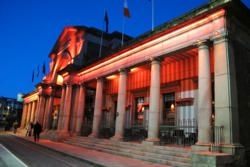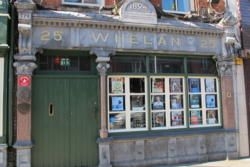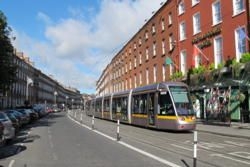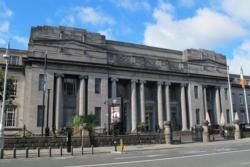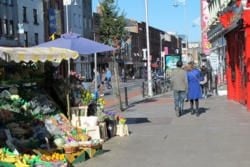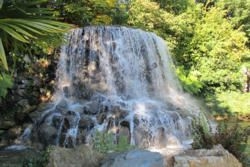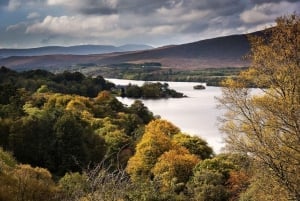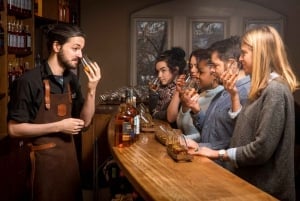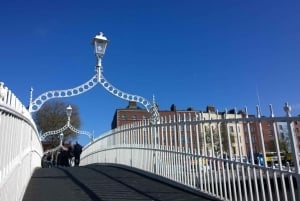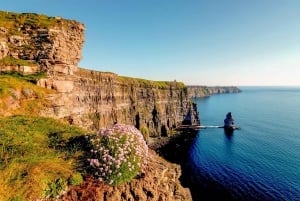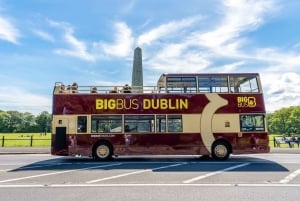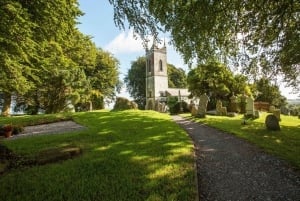Camden-Wexford-Harcourt Street Area
Want to get your groove on? Like it loud and/or live? Head just southwest of St Stephen’s Green, where the DJ bars and music venues of
In addition to Camden-Wexford-Harcourt Streets, the 'Village Quarter' area includes the neighbourhood of Portobello. In the grand and confusing multiple-naming tradition of many Dublin thoroughfares, Wexford Street turns into Camden Street Upper, then becomes Camden Street Lower, then changes again into Richmond Road South (same road - only the names change as you travel southward). This route takes you through Portobello. Just just before you reach the Portobello Bridge which crosses the Grand Canal, you'll find Christy Bird - a treasure trove of furniture, antiques, and myriad things both weird and wonderful.
Camden/Wexford Street itself is enough to keep you entertained for at least a couple of evenings with the variety and sheer quantity of pubs, bars, cafés, clubs and restaurants on this compact stretch.
For starters, Whelan’s of Wexford Street has the twin virtues of being an important live music venue and also a well-known pub (records of a public house on this site date back to 1772). A bit more recently, a diverse selection of live acts began appearing, along with a selection of themed clubs running seven nights a week. Artists range from undiscovered local bands to big international names. In the latest Whelan's news, this much-loved location is celebrating its 25th Anniversary in 2014 by hosting some very special gigs.
Next door to famous big-sister Whelan’s, The Village is a newer ‘little’ sibling with its own club nights Monday-Saturday, plus a regular menu of other gigs and events. It also caters for seminars, art exhibitions, social events and the like in The Warehouse, a popular new addition to the venue.
Harcourt Street runs parallel to Camden/Wexford Street. At the top sits the Old Harcourt Street Station. Outside, there's a convenient LUAS line stop - inside, there's an impressive historic train station designed by George Wilkinson, originally opened in 1859. The last train left Harcourt Street Station at 4.25pm on 31st December 1958.
Decades later, part of this vast space housed Crawdaddy (an eclectic live venue) and Tripod (a multi-functional club/live music space), where some legendary gigs took place. Those venues are now dark, but Dublin nightlife carries on - The Odeon next door, opened in 1998 in the entrance to the former Harcourt Street Railway Terminus, rescued this majestic building by rehabilitating it after a prior soulless office conversion.
Further along the same street are a series of clubs and even - brace yourself - superclubs. If you’re in the mood for some serious decibels, crowds, queuing and aren’t opposed to meeting Mr or Ms Right (or was that Right Now?), jump into the fray and join an enthusiastic throng with the exact same thing in mind.
Visiting the area in the daytime, and fancy quieter/more cultural pursuits? Just off Harcourt Street is Clonmel Street, an apparent cul-de-sac. However wander down to the end where you’ll come to a couple of gates which don’t seem to lead much of anywhere. But it pays to persevere because on the other side lies something unexpected - one of the finest and least known of Dublin's parks and gardens.
The Iveagh Gardens (pronounced ‘ivy’) were designed by the interestingly-monikered Ninian Niven in 1865. Hidden away in this ‘secret’ garden are an abundance of statues and fountains, plus rolling lawns and many original features restored since a revamp commenced in 1995. Festivals, events and concerts are also held here, most recently hosting the Taste of Dublin food festival, Imelda May, Damien Dempsey and Glen Hansard. The gardens are also accessible from Hatch Street.
And if your musical tastes tend more towards Mozart and Wagner rather than Madonna and One Direction, the National Concert Hall (An Ceoláras Náisiúnta) or NCH lies at the other side of the Iveagh Gardens on Earlsfort Terrace. Rated by performing artists as a great place to play, this establishment presents a line-up of world-renowned names. The NCH features weekly performances by the resident orchestra, as well as a range of performances covering classical, opera, traditional, jazz, musicals and popular music.
Photos, from top to bottom: Camden Street on a sunny afternoon; Whelan's; Harcourt Street; Iveagh Gardens; Old Harcourt Street Station; National Concert Hall


